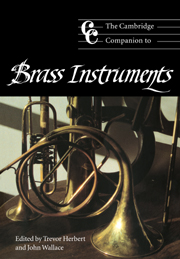Book contents
- Frontmatter
- Introduction
- 1 Lip-vibrated instruments of the ancient and non-western world
- 2 How brass instruments work
- 3 Design, technology and manufacture before 1800
- 4 Brass instruments in art music in the Middle Ages
- 5 The cornett
- 6 ‘Sackbut’: the early trombone
- 7 The trumpet before 1800
- 8 The horn in the Baroque and Classical periods
- 9 Design, technology and manufacture since 1800
- 10 Keyed brass
- 11 The low brass
- 12 Brass in the modern orchestra
- 13 Brass bands and other vernacular brass traditions
- 14 Playing, learning and teaching brass
- 15 The post-classical horn
- 16 Jazz, improvisation and brass
- 17 Brass solo and chamber music from 1800
- 18 Frontiers or byways? Brass instruments in avant-garde music
- Glossary
- Notes
- Select bibliography
- Index
3 - Design, technology and manufacture before 1800
Published online by Cambridge University Press: 28 September 2011
- Frontmatter
- Introduction
- 1 Lip-vibrated instruments of the ancient and non-western world
- 2 How brass instruments work
- 3 Design, technology and manufacture before 1800
- 4 Brass instruments in art music in the Middle Ages
- 5 The cornett
- 6 ‘Sackbut’: the early trombone
- 7 The trumpet before 1800
- 8 The horn in the Baroque and Classical periods
- 9 Design, technology and manufacture since 1800
- 10 Keyed brass
- 11 The low brass
- 12 Brass in the modern orchestra
- 13 Brass bands and other vernacular brass traditions
- 14 Playing, learning and teaching brass
- 15 The post-classical horn
- 16 Jazz, improvisation and brass
- 17 Brass solo and chamber music from 1800
- 18 Frontiers or byways? Brass instruments in avant-garde music
- Glossary
- Notes
- Select bibliography
- Index
Summary
Early technical developments
The emergence of the brass family as instruments to be used in art music is directly related to their ability to produce sufficient notes in the diatonic scale for melodic accompaniment. This is effected in two ways: either by changing tube length during playing by means of slides so as to fill in the gaps in the lower register, or by increasing tube length to a point where the higher harmonics are available to the player and close enough together that diatonic melodies may be played. Until the higher harmonics could be produced reliably, or the lower harmonics tuned to order, brass instruments were relegated to ceremonial and non-musical roles.
The simplest way of varying tube length is by application of a single slide attached to the mouthpiece. The mouthpiece is held in a set position against the lips while the whole instrument is moved up and down. Several authors cite extensive iconographical and musical evidence for the existence of such an instrument from the fourteenth and fifteenth centuries, and hypothesise on its general dimensions and musical function. Modern reconstructions show that the instrument is at least mechanically and musically feasible. An argument against the existence of an instrument with a single slide has been made, but from the point of view of manufacturing technique it seems more logical that a workable but cumbersome single slide was developed first, and later gave way to an improved double slide as manufacturing techniques improved. Making smooth concentric tubing which would telescope easily enough to allow the use of a single slide was difficult enough in the fourteenth century, without the extra technical demands of making two such tubes work well alongside each other in a double slide.
- Type
- Chapter
- Information
- The Cambridge Companion to Brass Instruments , pp. 24 - 37Publisher: Cambridge University PressPrint publication year: 1997
- 2
- Cited by



